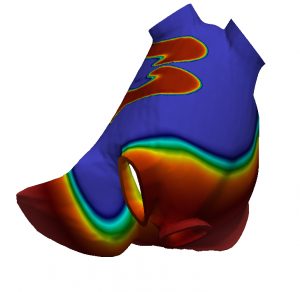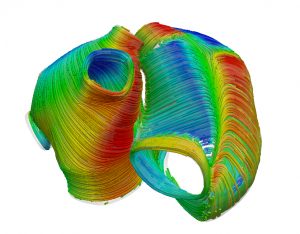Boyce Griffith, PhD, Associate Professor of Mathematics, member of the McAllister Heart Institute, and Adjunct Faculty in the Departments of Applied Physical Sciences and Biomedical Engineering, has received a $2.8-million award from the National Institutes of Health for a new 5-year project, Multiscale Modeling of Clotting Risk in Atrial Fibrillation. This is a multi-institutional project led by UNC but also involving Duke and the University of Utah. UNC co-investigators include John Vavalle, MD, Assistant Professor of Medicine in the Division of Cardiology.

Boyce Griffith, PhD, Associate Professor of Mathematics, member of the McAllister Heart Institute, and Adjunct Faculty in the Departments of Applied Physical Sciences and Biomedical Engineering, has received a $2.8-million award from the National Institutes of Health for a new 5-year project, Multiscale Modeling of Clotting Risk in Atrial Fibrillation. This is a multi-institutional project led by UNC but also involving Duke and the University of Utah. UNC co-investigators include John Vavalle, MD, Assistant Professor of Medicine in the Division of Cardiology.


Boyce Griffith, PhD, Associate Professor of Mathematics, member of the McAllister Heart Institute, and Adjunct Faculty in the Departments of Applied Physical Sciences and Biomedical Engineering, has received a $2.8-million award from the National Institutes of Health for a new 5-year project, Multiscale Modeling of Clotting Risk in Atrial Fibrillation. This is a multi-institutional project led by UNC but also involving Duke and the University of Utah. UNC co-investigators include John Vavalle, MD, Assistant Professor of Medicine in the Division of Cardiology. The Duke team is led by Craig Henriquez, PhD, Professor of Biomedical Engineering and of Mechanical Engineering, and the Utah team is led by Aaron Fogelson, PhD, Professor of Mathematics and Adjunct Professor of Bioengineering.
This project will develop clinically validated computer models of cardiac dynamics to simulate intracardiac flows and blood coagulation in atrial fibrillation (AF). AF is the most common sustained arrhythmia in the U.S. and is associated with serious clotting-related complications, including thromboembolism and stroke. Anticoagulation is commonly prescribed to patients who have an elevated stroke risk. However, current risk assessment indices lack individualization based upon atrial structure or function, and they classify most AF patients as being at intermediate clotting risk. The core hypothesis motivating this research is that these risk assessment metrics may result in many AF patients receiving unneeded anticoagulation and unnecessary monitoring for thrombosis. The long-term objective of this research is to develop new, broad-spectrum approaches to clotting risk assessment in AF that provide personalized risk prediction. Towards this goal, this project specifically aims to develop comprehensive models of atrial dysfunction to enable mechanistic studies of flow and clotting in AF that will ultimately facilitate individualized treatment.
The principal computer modeling approaches that will be developed in this project can also be deployed to simulate blood clot formation in a range of significant medical conditions (venous thromboembolism, deep vein thrombosis) and as associated with medical devices (prosthetic heart valves, ventricular assist devices, IVC filters). Such models could also be used to aid in the development of novel biomaterials. Ultimately, computer models of medical devices leveraging this simulation platform could be used to predict device performance in submissions to regulatory agencies such as the Food and Drug Administration.
This project is funded through NIH’s Predictive Multiscale Models for Biomedical, Biological, Behavioral, Environmental and Clinical Research U01 program, which is focused on computer modeling and simulation and is part of the Interagency Modeling and Analysis Group, an NIH-supported consortium that aims to promote and support research that requires the development of new and novel modeling and analysis methods.